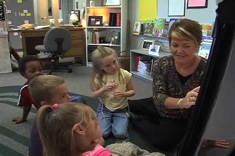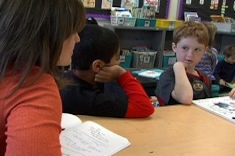I’ll never forgot the Friday night I tiptoed into my son’s room to give him one last kiss and could not find him. Rather than seeing him snuggled up in his bed with his blankets, I found him buried beneath a stack of books with a pack of sticky notes and a marker by his side. As I took a few steps closer, I saw that he had attached a sticky note to each of the books once on his bookshelf, now on his bed, and labeled each note with a number.
As I gently tried to remove the books from his bed, my son woke up and told me what he had been doing: he had decided to level his books to see which ones he was allowed to read . . . and which ones he was not. Since we had never discussed the idea of reading levels at home, I knew this was something that must be weighing on his mind from school, and I was right. Over breakfast the next morning, he told me how he really wanted to read a book from a certain bin at school, but was not able to because it was not at his level. Reading became inaccessible to him. My heart broke for him that morning and continues to break for each child who feels this way about books and their reading abilities.
Unfortunately, I know my son is not alone in his struggle. I have heard far too many stories about children unable to read books they want to read from their leveled classroom library. I have heard about libraries leveling their collection and requiring students to read from particular shelves. I have overheard parents in local bookstores denying their children books because they do not fit the predetermined level reported by their teacher. I have even seen displays of reading levels in schools for all to view. One was a beautiful construction paper tree with cut-out leaves labeled with students’ names . . . and their reading levels. Another was a set of student astronauts blasting off to different planets, each labeled with their reading levels. Another was just a simple list of student names and levels placed prominently by the classroom library. Now, I know these teachers, librarians, and parents are not intentionally crushing children’s reading spirits and harming their reading development, but they are. I know they have the best intentions of helping their students and children choose books that are at the right reading level to ensure success, but they do not realize the damage they might be doing in the process. Seeing my son surrounded by leveled books in bed gave me the courage to do something about it.
Standing on the shoulders of those who have written, blogged, and tweeted about this very topic, I tried something quite bold in a professional development session. I gave each teacher a sticky note to post for the whole group and asked them to label it with their name . . . and their weight. As they looked at me incredulously, I said that if they were not willing to share that information, they could write down their salary or age.
Many started whispering with the teacher beside them about my request, and they looked at me with disdain. I asked them to stop in the moment and think about how they felt about publicly sharing such personal information. They told me that it was inappropriate and not something that should be shared. They told me they were hurt and angry, as if I was violating a sense of trust we shared about teaching and learning. I reminded them that reading levels are just as important and personal for students, and that making them public knowledge might give students that same sense of angst that I had created in them. Something so personal, so sacred, and so tied to our identities of who we are as readers should not be shared unless we choose to do so. It was a powerful moment and led to some very raw and honest conversations with well-intentioned school faculty about reading and readers, conversations that shifted the culture of the buildings.
I am sure that you have encountered your own situations where reading levels were privileged over readers. Boldly challenge that thinking and place your teachers in the position of students to see what their practices might unintentionally be doing to developing readers. Shift teachers’ attention to teaching readers over reading levels. If we privilege the reading behaviors of students, rather than the reading levels, we teach students that readers learn, grow, and change based on every book they encounter. We teach them that they have the power to choose books and alter their habits as readers to fit their needs, purposes, and motivations. We teach them that they have the power to decide who they will become as readers. Once they feel that power, they can go anywhere.









